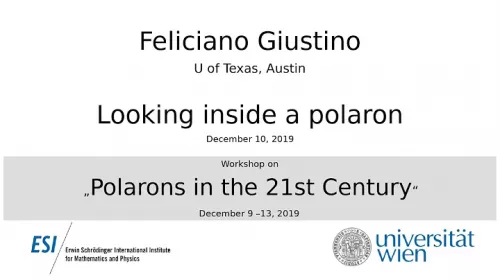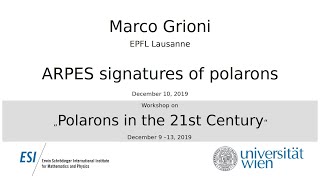Polarons in the 21st Century
Objective:
Gathering together an interdisciplinary group of researchers working on polaron physics from different perspectives, including: first-principles calculations, quantum-field Hamiltonian approaches, theoretical/mathematical models, and experiments, representative of the condensed-matter and ultracold atoms communities. The workshop will offer the opportunity to report the status of the art, discuss new ideas, developments and establish possible interactions among the different communities.
Scientific aim of the workshop
The polaron concept was proposed by Landau in 1933 [1] to describe an electron moving in a dielectric crystal where the atoms are displaced from their equilibrium positions to screen the charge of the electron. Depending on the spatial extent of the polaron wavefunction and associated structural distortions two general types of polarons can be identified: small-polaron and large-polaron. Historically [2], the polaron problem has been studied using quantum field theory effective Hamiltonians: the large-polaron Fröhlich Hamiltonian [3] within the ‘continuum approximation’ and the small-polarons models of Yamasita-Kurosawa [4] and Holstein [5] describing the ‘hopping’ motion of small polarons. Feynman developed a superior description for the Fröhlich polaron, using path integrals [6], which represented a corner-stone in the theory of polarons, but these models Hamiltonians are often too complex to be solved analytically (for all electron-phonon coupling strength), and approximations are often needed. Many of these approximations and methods were contributed by Jozef Devreese and his collaborators in Antwerpen. Most notably, the optical response of polarons was elucidated using path integral techniques [7]. The optical response continues to allow detecting and identifying polarons in many materials of importance, most recently in superconducting strontium titanate.
Researchers have also tried to study polarons using analog systems consisting of gases of ultracold atoms. The results of these simulations provide insights into the underlying physics, as well as offer verification for the approximations made in polaron models [8]. More recently, first principles methods based on suitable extension of the density functional theory (DFT) turned out to provide an accurate microscopic description of both large and small polarons and predicted material-specific polaron properties [9,10,11,12]. Using DFT-based approaches the Vienna co-organizers (Franchini & Kresse) have opened the way to obtain more realistic, first-principles based Hamiltonians for polarons in many specific materials.
The field of polarons has not only been a testing ground for the development of novel analytical, semi-analytical, and numerical techniques. In fact, polarons are central to the often exotic behavior of oxides and polar semiconductors and are of key importance in photonic, photovoltaic, and photochemistry applications. The physical properties of the polaron (mobility, effective mass, optical characteristics, etc.) can be very different from those of the bare electron, leading to strong modifications of the electrical, thermal transport and even catalytic properties of the material. From the experimental point of view, there are different type of measurements that can be conducted which can provide useful insights on the properties of polarons both in real materials (Electron paramagnetic resonance, EPR [13], Angle resolved photoemission spectroscopy, ARPES [14], Scanning tunneling microscopy [9], UV/IR spectroscopy [15] and time-resolved optical Kerr, effect TR-OKE [10]) and in ultracold atoms [16, 17].
In this workshop we plan to provide an overview of the state of the art of polaron physics, actual challenges and future directions of research, by congregating international renowned experts coming from interdisciplinary sub-fields of physics, representative of the variegated scientific communities working on the polaron physics. Specifically:
A) Theory of polarons using effective quantum-field Hamiltonians. Following the tradition based on the seminal works of Landau, Fröhlich, Holstein, Feynman and Bogoliubov, the polaron problem stimulated a lot research aiming to solve the polaron Hamiltonians using different type of techniques, such as path integrals, strong-coupling perturbation expansions, advanced variational and exact diagonalization, Diagrammatic Monte Carlo, Dynamical Mean Field Theory.
B) Ultracold atoms. Gases of ultracold atoms, which can be artificially realized using very advanced methods such as laser cooling and evaporative cooling, represent an ideal playground for studying quantum phase transition including Bose-Einstein condensation (BEC) but also Bose and Fermi polarons. The great experimental control available in ultracold atoms provides valuable insights into the properties of interacting quantum systems and provide a unique platform to verify advanced numerical schemes.
C) First-principles quantum-mechanical modeling. First-principles approaches based on density functional theory represent a powerful theoretical and computational tool to model polarons in real materials and acquire informations on material-dependent properties. In the past 10 years there have been an upsurge of interest in the realistic modeling of polarons using DFT and a few new approaches have been proposed to improve the treatment of electron localization and electron-phonon interactions.
D) Experiments on polaronic materials. Since the first experimental observation of polaron in UO2 in 1963 several new measurements have been conducted to disclose fingerprints of polaronic behavior in materials. Not many experimental probes can be employed to inspect the nature of polarons in materials, in particular EPR, STM and ARPES, but also XPS,TR-OKE. In most cases the support of first principles calculation in necessary to provide a sound interpretation of the observations.
References:
[1] Electron motion in crystal lattices, L. D. Landau, Phys. Z. Sowjetunion 3, 664 (1933).
[2] Advances in Polaron Physics, A. S. Alexandrov and J. T. Devreese, (Springer Series in Solid-State Sciences, Vol. 159, Springer, 2009).
[3] Electrons in lattice fields, H. Fröhlich, Adv. Phys. 3, 325 (1954).
[4] On electronic current in NiO, J. Yamashita and T. Kurosawa, Phys. Chem. Solids 5, 34 (1958);
[5] Studies of polaron motion: Part II. The small polaron, T. Holstein, Ann. Phys. (USA), 8, 343 (1959).
[6] Slow Electrons in a Polar Crystal, R. P. Feynman, Phys. Rev. 97, 660 (1955).
[7] Optical Absorption of Polarons in the Feynman–Hellwarth–Iddings–Platzman Approximation, J.T. Devreese, J. De Sitter, M. Goovaerts, Phys. Rev. B. 5, 2367 (1972).
[8] Viewpoint: Bose Polarons that Strongly Interact, Fredric Chevy, Physics 9, 86 (2016); see also Diagrammatic Monte Carlo study of the Fröhlich polaron dispersion in 2D and 3D, T. Hahn, S. Klimin, J. Tempere, J. Devreese, and C. Franchini, Phys. Rev. B 97, 134305 (2018).
[9] Direct View at Excess Electrons in TiO2 Rutile and Anatase, M. Setvin, C. Franchini, X. Hao, M. Schmid, A. Janotti, M. Kaltak, C. G. Van de Walle, G. Kresse, and U. Diebold, Phys. Rev. Lett. 113, 086402 (2014).
[10] Large polarons in lead halide perovskites, Kiyoshi Miyata, Daniele Meggiolaro, M. Tuan Trinh, Prakriti P. Joshi, Edoardo Mosconi, Skyler C. Jones, Filippo De Angelis and X.-Y. Zhu, Sci. Adv. 2017; 3:e1701217
[11] Polaron-driven surface reconstructions,
M. Reticcioli, M. Setvin, X. Hao, P. Flauger, . Kresse, M. Schmid, U. Diebold, C. Franchini
Phys. Rev. X 7, 031053 (2017)
DOI:https://doi.org/10.1103/PhysRevX.7.031053
[12] Electron-phonon interactions from first principles. Feliciano Giustino. Rev. Mod. Phys. 89, 015003 (2017)
[13] Intrinsic small polarons in rutile TiO2, Shan Yang, A. T. Brant, N. C. Giles, and L. E. Halliburton, Intrins Phys. Rev. B , 87 125201 (2013).
[14] Tunable Polaronic Conduction in Anatase TiO2, S. Moser, L. Moreschini, J. Jaćimović, O. S. Barišić, H. Berger, A. Magrez, Y. J. Chang, K. S. Kim, A. Bostwick, E. Rotenberg, L. Forró, and M. Grioni, Phys. Rev. Lett. 110, 196403 (2013).
[15] Evidence for photogenerated intermediate hole polarons in ZnO, H. Sezen, H. Shang F. Bebensee, C. Yang, M. Buchholz, A. Nefedov, S. Heissler, C. Carbogno, M. Scheffler, P. Rinke,
C. Wöll, Nature Communications 6, 6901 (2015).
[16] Bose Polarons in the Strongly Interacting Regime, M.-G. Hu, M. J. Van de Graaff, D. Kedar, J. P. Corson, E. A. Cornell, and Deborah S. Jin, Phys. Rev. Lett. 117, 055301 (2016).
[17] Observation of Attractive and Repulsive Polarons in a Bose-Einstein Condensate, N. B. Jørgensen, L. Wacker, K. T. Skalmstang, M. M. Parish, J. Levinsen, R. S. Christensen, G. M. Bruun, and Jan J. Arlt, Phys. Rev. Lett. 117, 055302 (2016).
Polaron physics through the XX and XXI centuries
Strategies for Modeling Polarons using Electronic Structure Methods
New perspective on magnetic polarons in antiferromagnetic Mott insulators from cold atoms
Polarons on Oxides Detected by Infrared-Reflection Absorption Spectroscopy (IRRAS): The Case of TiO2 and ZnO
Vibrations and their Impact on Electronic and Transport Properties of Organic Materials
Direct first-principles calculation of polarons in Koopmans-corrected DFT
Electronic structure of YTiO3 and the charge transport through small polaron hopping
Looking inside a polaron
Diagrammatic Monte Carlo for Polarons from First Principles
Polaron mobility and response functions in the Feynman variational approximation
Multi scale modelling of organic devices and perovskite solar cells
Quasiparticle approach to molecules rotating in quantum solvents
Diagrammatic Monte Carlo approach to angular momentum in quantum many-body systems
ARPES signatures of polarons
Polaronic satellites in angle-resolved photoemission spectra from ab initio many-body calculations
Engineering Defect Transition-Levels through van der Waals Heterostructure
Interplay between small polarons and water on TiO2 surfaces
Two-dimensional polarons: the case of monolayer BN
Interactions of O2 and CO molecules with small electronic polarons on the TiO2 (110) surface
Polarons in Fe2O3: Affecting H2O Diffusion and Desorption
(poster) Feynman path-integral treatment of the Bose polaron beyond the Fröhlich model
Electron scattering and bound states in the presence of polaronic impurities
Beyond-Fröhlich Hamiltonian for large polarons in anharmonic solids (Poster presentation)
Electron-Phonon Interactions using the Projector-Augmented-Wave Method
Polarons at ferroelectric domain walls in BiFeO3
Optoelectronic Properties and Defect Physics of Lead-free Photovoltaic Absorbers Cs_2Au^(I)Au^(III)X_6 (X=I, Br)
Lattice Dynamics and Electron-phonon coupling in Lead free Bi3+ Alloyed Cs2AgInCl6 Double Perovskite Nanocrystals
POSTER: From polarons to bipolarons in Bose-Einstein condensates.
The Fröhlich polaron at strong coupling
Disorder-induced polarons in strongly disordered metals (and doped oxides)
Polarons and intrinsic electron and hole trapping in amorphous oxides
Polaronic effects in titanium and iron oxides by hybrid density functional theory calculations.
Ferroelectric Polarons and Belgian Waffles in Lead Halide Perovskites
Polarons in photoabsorbing materials: Role in solar cells and water-splitting devices
Polaronic effects in condensed matter and atomic systems
Disorder in order: simulating a random scattering potential with a randomless cold atom system
Impact of small polarons on the properties of transition-metal oxides
The 2N+1 body problem: An impurity immersed in a strongly correlated fermionic superfluid
Universal dynamics of impurities in a Bose-Einstein condensate
Combined STM/AFM: Watching polarons at the atomic level
Localized and Delocalized Excess Electrons States in Reduced Anatase TiO2
Band-Electron vs. Polaron Mobility in Metal–Halide Perovskites
Equilibrium and response properties of a many-polaron gas
Intrinsic polaron formation and influence on the surface chemical properties
Simulating Small Polarons from First Principles: The DFT supercell approach
Surface Polarons Reducing Overpotentials in the Oxygen Evolution Reaction
Organizers
| Name | Affiliation |
|---|---|
| Jozef Devreese | University of Antwerpen |
| Cesare Franchini | University of Vienna |
| Georg Kresse | University of Vienna |
| Jacques Tempere | University of Antwerpen |
Attendees
| Name | Affiliation |
|---|---|
| Luis Ardila | Institut für Theoretische Physik |
| Jan Arlt | University of Aarhus |
| Sergey Artyukhin | Italian Institute of Technology, Genova |
| Vijaya Begum | University of Duisburg-Essen |
| Giacomo Bighin | Institute of Science and Technology Austria |
| Ji Chen | Peking University |
| Frédéric Chevy | Ecole Normale Supérieur Paris |
| Sergio Ciuchi | University of L'Aquila |
| Aaron Deskins | Worcester Polytechnic Institute |
| Behnood Dianat | University of Modena and Reggio Emilia |
| Ulrike Diebold | Technical University of Vienna |
| Cristiana Di Valentin | University of Milano-Bicocca |
| Manuel Engel | University of Vienna |
| Stefano Falletta | EPFL, Lausanne |
| Elaheh Ghorbani | Technical University Darmstadt |
| Supriti Ghorui | IIT Bombay |
| Elio Giamello | University of Torino |
| Feliciano Giustino | University of Texas at Austin |
| Patrick Gono | EPFL, Lausanne |
| Xavier Gonze | Université Catholique Louvain |
| Marco Grioni | EPFL, Lausanne |
| Juan Guerra | University of Giessen |
| Thomas Hahn | University of Vienna |
| Kurt Hingerl | Universität Linz |
| Matthew Houtput | University of Antwerpen |
| Timour Ichmoukhamedov | University of Antwerpen |
| Jiban Kangsabanik | Indian Institute of Technology Bombay |
| Volker Karle | Institute of Science and Technology Austria |
| Serghei Klimin | University of Antwerpen |
| Joannis Koepsell | Max Planck Institute of Quantum Optics |
| Sebastian Kokott | Fritz-Haber-Instiut der Max-Planck-Gesellschaft |
| Sabine Körbel | Trinity College |
| Juraj Krsnik | Institute of Physics |
| Stephan Lany | National Renewable Energy Laboratory |
| Iflah Laraib | University of Delaware |
| Mikhail Lemeshko | Institute of Science and Technology Austria |
| Matthias Meier | Technical University of Vienna |
| Jarvist Moore Frost | Imperial College London |
| Frank Ortmann | Technische Universität Dresden |
| Michel Panhans | Technische Universität Dresden |
| Michele Reticcioli | University of Vienna |
| Felix Rose | Max Planck Institute of Quantum Optics |
| Richard Schmidt | Max Planck Institute of Quantum Optics |
| Robert Seiringer | Institute of Science and Technology Austria |
| Annabella Selloni | Princeton University |
| Martin Setvin | Technical University of Vienna |
| Alexander Shluger | University College London |
| Akash Singh | Indian Institute of Science, Bengalore |
| Weng Hong Sio | University of Oxford |
| Igor Sokolović | Technical University of Vienna |
| Chris Van de Walle | University of California, Santa Barbara |
| Enrico Varesi | Micron Technology, Inc. |
| Carla Verdi | University of Vienna |
| Alison Walker | University of Bath |
| Julia Wiktor | Chalmers University of Technology |
| Matthew Wolf | University of Bath |
| Christof Wöll | Karlsruhe Institute of Technology |
| Xiaoyang Zhu | Columbia University |
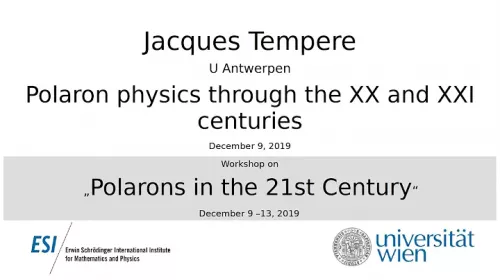
Dec. 9, 2019 09:40 — 10:40
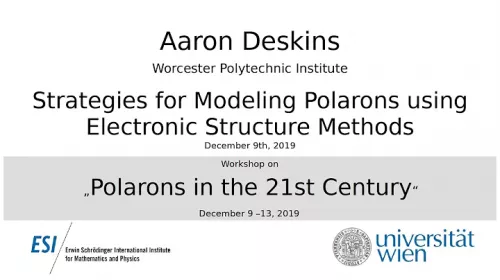
Dec. 9, 2019 10:40 — 11:20
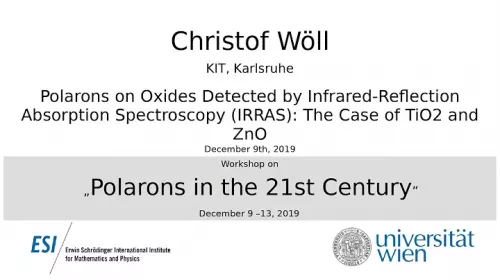
Dec. 9, 2019 14:00 — 14:40
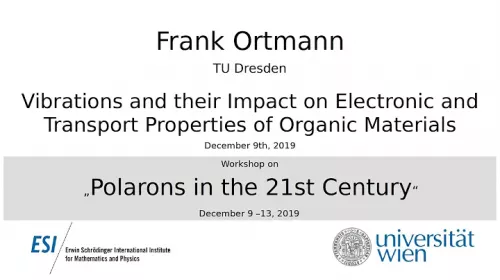
Dec. 9, 2019 14:40 — 15:00
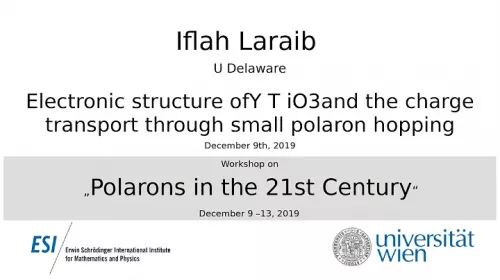
Dec. 9, 2019 16:10 — 16:30
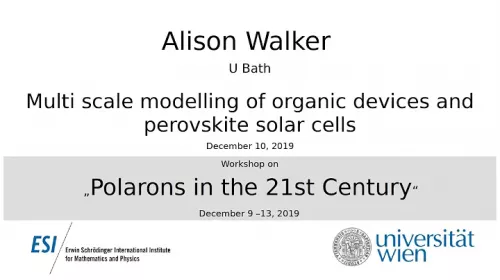
Dec. 10, 2019 11:40 — 12:20
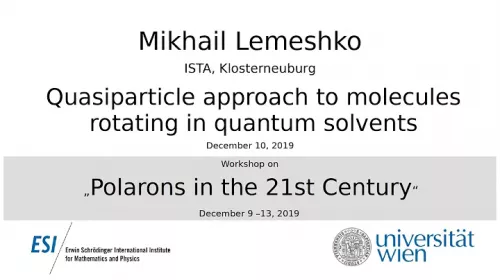
Dec. 10, 2019 14:00 — 14:40
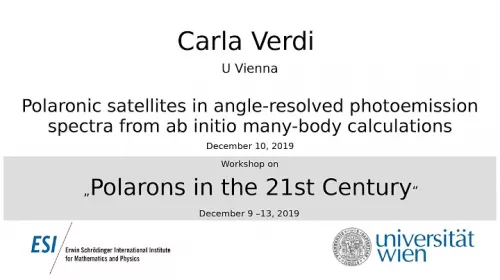
Dec. 10, 2019 16:10 — 16:30
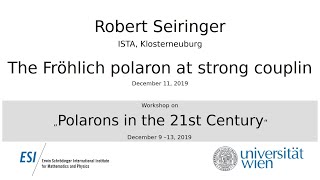
Dec. 11, 2019 09:00 — 09:40
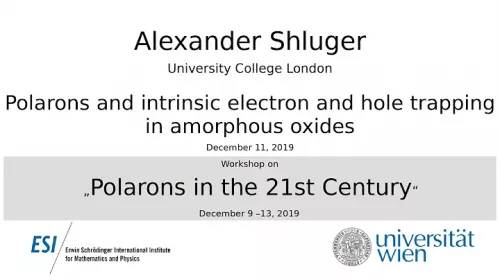
Dec. 11, 2019 11:00 — 11:40
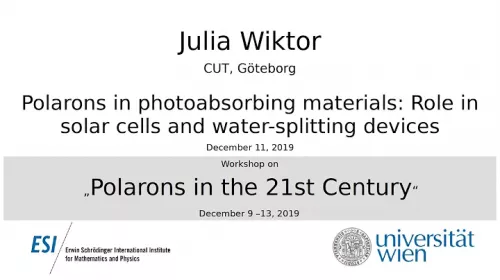
Dec. 11, 2019 14:40 — 15:00
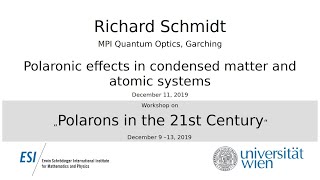
Dec. 11, 2019 15:30 — 16:10
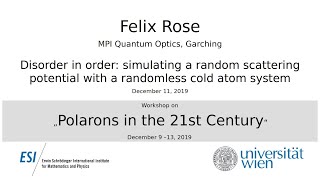
Dec. 11, 2019 16:10 — 16:30
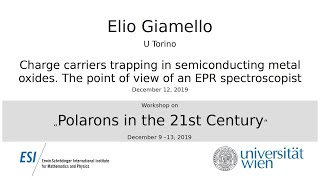
Dec. 12, 2019 09:00 — 09:40
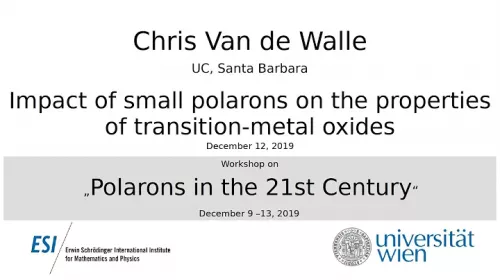
Dec. 12, 2019 09:40 — 10:20
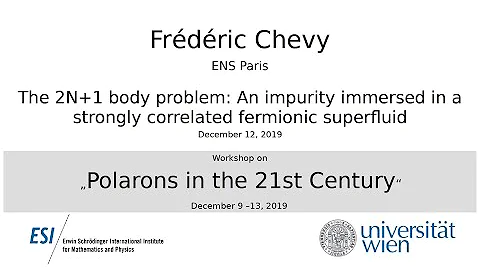
Dec. 12, 2019 11:00 — 11:40
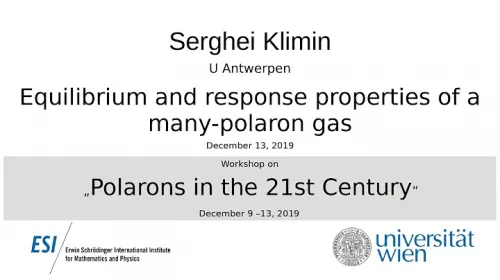
Dec. 13, 2019 09:00 — 09:40
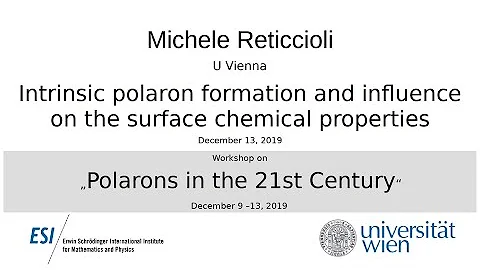
Dec. 13, 2019 09:40 — 10:20
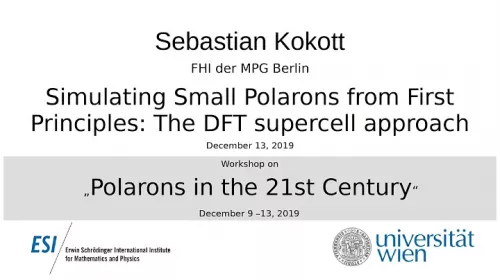
Dec. 13, 2019 11:00 — 11:40
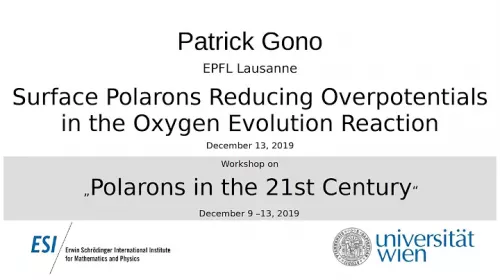
Dec. 13, 2019 11:40 — 12:00
- Type:
- Workshop
- When:
- Dec. 9, 2019 — Dec. 13, 2019
- Where:
- ESI Boltzmann Lecture Hall
- Organizer(s):
-
Jozef Devreese (U Antwerpen)
Cesare Franchini (U of Vienna)
Georg Kresse (U of Vienna)
Jacques Tempere (U Antwerpen)
- More:
- Website
